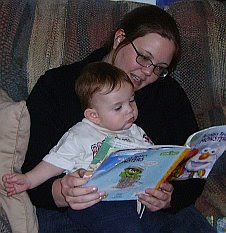Sunday, October 24, 2010
It's blogtastic
Wednesday, May 12, 2010
How Do Dinosaurs Say I Love You? by Jane Yolen
Monday, May 10, 2010
The Seeing Stick by Jane Yolen

Pages: 30
Thursday, March 18, 2010
Saved by the Music by Selene Castrovilla
 Pages:280
Pages:280 Monday, March 15, 2010
Come to the Fairies' Ball by Jane Yolen
Tuesday, February 16, 2010
Don't Know Where, Don't Know When by Annette Laing
 Pages: 209
Pages: 209Ages: 9+Publication:
Already Available (2007)
When Hannah, Alex, and Brandon skip out on their summer extracurriculars to wander the campus of Snipesville State College, they wander into the college library. In the library, the children meet a mysterious professor and then find themselves magically transported to WWII England.
The children are asked to take on new names, participate in London evacuations, and solve the mystery of a missing child. Can three American children survive in WWII England? And more importantly, can the children solve the mystery in time?
In her debut novel, Annette Laing delivers. This novel is slow to start, but once the story gets going it is hard to put down the book. Part historical fiction, part mystery, part modern teen lit, and part sci-fi, Laing creates a unique storyline that has something for everyone.
With a wide geographical and temporal range, Laing gently compares and contrasts the lives of modern children in the U.S. with those of children from two different time periods in England. All three settings are during times of war, however the modern U.S. children seem blissfully unaware as to the goings on in the Eastern hemisphere whereas the children in England have bombs being dropped on their doorsteps. Astute readers will be able to draw meaning from Laing’s parallels and juxtapositions.
While the plot and action of the storyline were well developed, I feel like the characters were a little underdeveloped in places. The professor seemed more of a literary device than a person, especially after the forward takes the time to introduce her work to the audience. The professor appears and disappears at various times, but never seems to really give the children any help, or illuminate the story for readers.
Perhaps the main thing that bothers me is that I really don’t like Hannah. The character doesn’t seem to learn much from her hardships. I was actually happy when she was given an old fashioned spanking. On the other hand, Laing may be getting at something very real with Hannah. At her age, Hannah is beginning to form her own opinions and question authority. Regardless of her “issues,” Hannah is coming into her own—a transition that is hard to make no matter what time period one might be in.
What I liked about the book was all the things that the children do get to experience. It is a realistic look at the way things were in WWI and WWII England. I also appreciated the different takes on racism throughout the book. It startled me to hear that blacks were treated so badly in England, and I laughed out loud then the dentist put English superiority into stark perspective. I also like that the foods aren’t so delicious and that children were looked at in a different light during the wars.
In all, I really enjoyed reading this book and I look forward to more adventures with Hannah, Alex, and Brandon.
Rating: 4 Pages
Monday, January 11, 2010
By the Sword by Selene Castrovilla
When America went to war for independence from the British, so did Benjamin Tallmadge. A school teacher by trade, Tallmadge gave up his profession and joined many other young men in the pursuit of freedom; freedom by the sword, the cannon, and the rifle. But what is it really like to give up the safety of your old life and enter the chaos of the Revolutionary war? Benjamin would soon find out.
Castrovilla paints a vivid picture of what life was like as a member of George Washington’s troops. Based on a memoir and other historical documents, the author creates a work of historical fiction that not only encompasses the brutality of wartime, but shows the human side as well.
Castrovilla eschews the usual “glory” of war stories in children’s history books and tells it like it was. The story’s main character endures days in a muddy trench, eats tiny rations of raw meat, and fears for his life every time the thunder rolls. This realism is refreshing in that Castrovilla gives history with the ugly and the good; she recognizes, in specifics, just what sacrifices soldiers of that time were asked to make.
The main character, Benjamin Tallmadge, brings to life the human aspects of wartime. His thoughts, actions, worries, and fears clue readers into just how much the American side struggled during the Revolutionary war. When Benjamin forgets his horse, Highlander, during an undercover flight for safety, he risks his life to retrieve his beloved animal. Even during a war, Benjamin protected his pet as he protected himself.
Bill Farnsworth adds more to the story with haunting and slightly out of focus illustrations. Oil paintings that lack sharp focus and minute details serve as both metaphor of the haze of war and a reminder that history remembers big events, not the small details—sometimes the small details are lost all together! The soft focus and muted colors also help to show the violence, but leave the graphic stuff to readers’ imaginations.
Interesting, intimate, and involved; this book is a good introduction to the Revolutionary war as it truly was. The happy ending will keep young readers from getting overwhelmed and serves as confirmation that troublesome times can lead to better times. This should be a classroom staple.
Rating: 4 Pages



